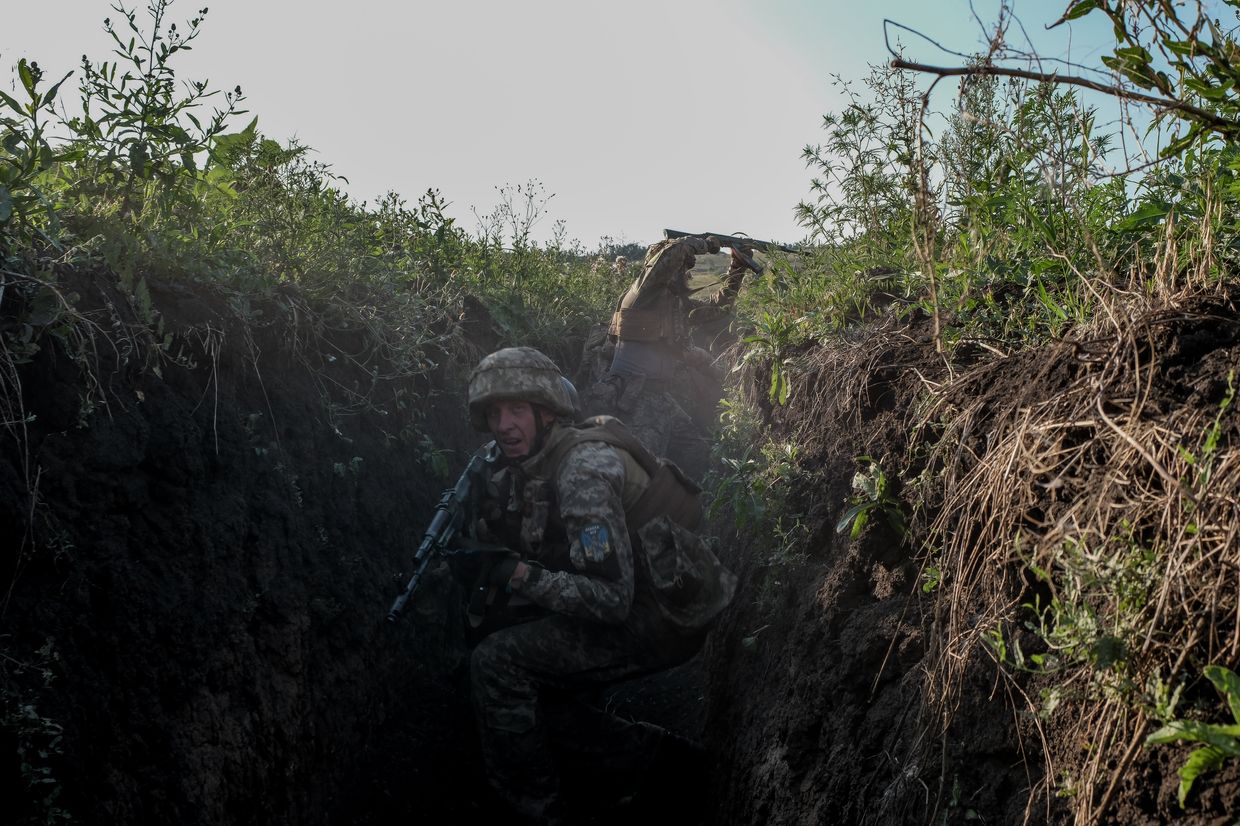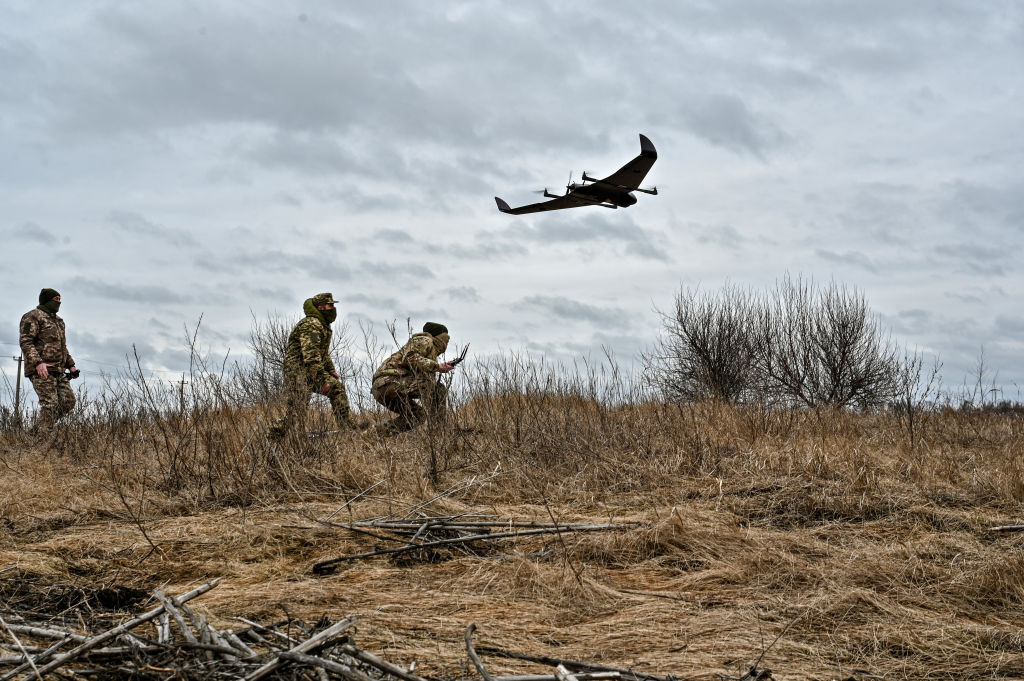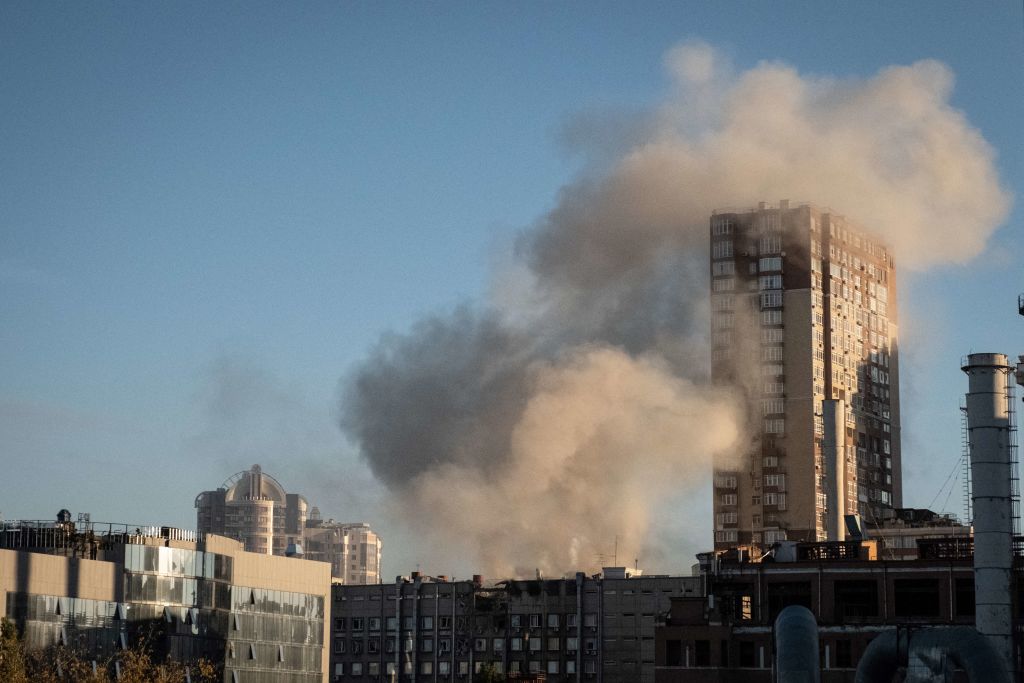Deadly drone arms race intensifies as Ukraine, Russia embrace the future of war

Editor’s note: The soldiers featured in this article are identified by first name and callsign only for security reasons.
DONETSK OBLAST – One sunny day in eastern Ukraine, two grown men in pixel camouflage sit together in the shade of lush summer bushes on the edge of a field, playing what looks to be a highly immersive virtual reality video game.
One of them is clearly the main character. Fourty-four-year-old Yegor “Yeti,” wearing futuristic first-person goggles and holding a controller with a relaxed grip, soars over apple green fields, saturated with shell holes, towards his target. Beside him, Yegor’s spotter watches the live stream silently on two screens.
Yegor is, of course, not a pro gamer, but the pilot of a first-person-view (FPV) drone serving in the Adam Tactical Group, a special Ukrainian unit pioneering the ever-expanding use of these cheap, improvised precision strike weapons.
His prey today is a Russian BMP infantry fighting vehicle, sitting idle on the outskirts of the village of Klishchiivka, one of the key goals for Ukrainian forces counterattacking around the city of Bakhmut.
Flying out together with Yegor from a nearby position is another drone, a Chinese-made DJI Mavic of the kind used extensively by both sides for 24/7 front-line reconnaissance, artillery correction, and sometimes, makeshift bombing operations of their own.
Together, they navigate the fields, treelines, and ponds in search of the BMP.
“We should shout hello from above, maybe they’ll start moving around,” jokes Yegor in his goggles without any change in expression.
As they get closer, the video begins to break up, wobbling about and sometimes completely cutting out before the pilot climbs to bring it back.
Finally, the target is spotted. In the space of seconds, Yegor lines up the vehicle with his flight path and drops the drone’s payload. At least, that’s what should have happened.
“No explosion recorded,” comes the voice on the radio, answered by “That’s bad” from Yegor, sounding disappointed but not surprised as he flies his little bomber back to base.
When retrieved, the drone is found with the munition still attached. The quick release system, 3D-printed by Ukrainian volunteers who assembled the quadcopter, didn’t do the one job it had.

The expansive role of unmanned aerial vehicles (UAVs) on both sides of Russia’s war against Ukraine spans from basic reconnaissance all the up to long-range strikes deep into the enemy’s rear.
At this stage of a war that could last years more, both sides are getting serious with their drone game: ramping up production while always looking to come up with new innovations that could prove a game-changer on the battlefield.
Over August and September, the Kyiv Independent got an inside look at the Ukrainian effort, both on the battlefield with Adam Group, and with some of Ukraine’s top drone makers in the rear.
The picture that emerges is one of a thick patchwork of passionate grassroots organization, adapting and innovating at a breakneck speed, and shipping off their products straight to the units that need them.
Warning signs also abound. With plenty on their plate already, the Ukrainian military and state defense industry has, according to interviewees from the battlefield to the workshops, failed to do enough to support the home-grown drone industry.
Instead, the onus falls largely on volunteers and private enterprise, who, without the resources and coordination that state backing provides, face an uphill struggle to match Russia’s centralized military machine.
Far-fetched flight
Drooping power lines and untended fields line the route to the Adam Group positions south of Bakhmut. Taking one of the last turn-offs from the road into the occupied city of ruins, this is all territory recently reclaimed by Ukrainian forces in a series of counterattacks over spring and summer.
“We’re not going to stop and look for them, but these bushes are full of dead Russians,” said 38-year-old drone specialist Yevhen, who goes by the simple call sign of “Pilot,” as he buried his car into the thick foliage to stop it from being seen by Russian drones.
Milling around in their small, basic trench line, the team’s faces light up upon the arrival of Yevhen, who has brought them lukewarm pizza from nearby civilization.
Lunch is cut short though, as the area is soon targeted by the whistles and crashes of incoming Russian artillery. The enemy is just over four kilometers away. Cursing a nearby mortar team who have apparently done a shoddy job hiding their own car, the men shuffle into a cramped dugout.

The work of the Adam team is not all flying and explosions; each mission takes time to plan. Yegor had first heard about the BMP via a call on his radio, as more shells landed closer to the position.
"Hi, can you talk right now?" came the voice from headquarters.
"Hi, we are getting hit at the moment," Yegor answered.
"Listen, we spotted a BMP in Klishchiivka, about eight kilometers away, do you think you could smack it with a bomber?"
"First of all, tell me the coordinates, but secondly, while we are getting shelled, we are not planning to go out flying," came Yegor’s stern reply.
A native of occupied Donetsk serving in the military since 2014, Yegor learned to fly drones while wounded over autumn and winter last year, making unofficial visits to test his skills in the field before being released from rehabilitation.
Since then, he quickly made a name for himself as one of the top pilots in the unit. Still, Yevhen was skeptical that this mission was doable.
“Uh…” he sighed; “they should know perfectly well that that area is in one big hole, and at a distance like that…”
Located 70 meters lower than their position, a quick check of the team’s tactical map shows that Klishchiivka cannot be reached by the signal from their small radio tower.
For this reason, using a kamikaze drone is out of the question: the only option is to drop a bomb from high enough that the drone will still see. On this mission, the bombs are fashioned from chopped-up helicopter rockets, made to order by the team themselves.
“We will have to drop from a height of about 100 meters, to hit a vehicle with a high-explosive shell is very unlikely,” Yevhen said.
There is no computer assistance or fancy guidance tech at work here: just the muscle memory of the pilot, using a makeshift drone, dropping a makeshift munition with a makeshift release system.
“This is a children's toy that has been repurposed for use,” 52-year-old Adam Group drone technician Vitalii “Spaniard” told the Kyiv Independent at the team’s base further to the rear.
“They need not only technical support, you have to order somewhere, buying it takes a lot of time, and you also need to train the pilots. These are far from being standardized weapons.”
Despite the disappointment of the first flight, the team prepares a new drone, double-checks the release, and flies out east again.
‘Angry birds’
In an assuming empty office building in an undisclosed Ukrainian city, two young men work silently under the watchful eye of an older supervisor, as a squad of 3D printers labor away in the background.
One is soldering electronics together, gradually adding to a stack of near-complete FPV drones by his side. Their propellers are marked with the Ukrainian words for “Angry Birds,” a major Ukrainian initiative which has raised over $800,000 for FPV drones alone.
The other, 20-year-old Mykyta Ziukov, is tinkering with a much larger bird, a heavy quadcopter designed to drop larger munitions from above, but more importantly, act as a flying observation point, allowing smaller drones to fly much further without losing signal.

Aviation engineering student Ziukov, who left his native Crimea two years after Russia’s illegal annexation in 2014, is a textbook example of how countless technical specialists adapted their skills to join Ukraine’s grassroots drone production drive during the full-scale invasion.
"I had had enough after sitting at home for a month, I wanted to do something useful, and the opportunity arose through the university,” he told the Kyiv Independent.
“Our university teacher brought together a little group that assembled drones, and soon we started to make our own FPV drones from scratch.”
This facility is operated by Defender Army, an organization which brings together some of Ukraine’s top UAV producers under one roof, coordinating and certifying their production, and facilitating the drones’ delivery straight to front-line units.
Independently of Ukraine’s Defense Ministry, the private manufacturers’ products are purchased directly both by grassroots volunteer fundraising drives connected to units like Adam, or by larger-scale campaigns like Angry Birds.
According to Defender Army co-founder Denys Liubchenko, 29, the organization now oversees a potential production capacity of over 5,000 FPV drones per month.
Though the vast majority of their parts are manufactured in China, the team has made an effort to build reliable supply chains that go through third countries to reduce its vulnerability to potential future restrictions placed by Beijing.
As they scale up, Defender Army’s manufacturers also look to improve their product based on feedback from the battlefield.
“To improve the effectiveness of FPV drones, you need to work on a few factors,” Liubchenko said to the Kyiv Independent.
“Firstly, quality components: you need to understand where to get an uninterrupted supply of them, you need a logistics pipeline. Then you need people who are specialists at putting them together, and at a large scale there is a shortage.”


Echoing the opinions of many in the industry, Liubchenko resents the failure of the Ukrainian state to get involved in the domestic drone industry at the scale required, especially after Russia’s war had already started in 2014.
“If Ukraine had started working together with them at the right time, firstly, this would have sped up the development of such solutions, and these products would have been certified before the beginning of the full-scale invasion,” he said. “Maybe some of the highest-quality and most innovative new technologies will have been tested and used somewhere in the world already, we would be exporting them.”
“Now, we have this situation where the majority of the work is carried on the shoulders of the manufacturers themselves, they handle the diversification of the products, the refining of the ‘birds,’ the improvement of technical specs and flight characteristics, the upsizing of production, and so on.”
In the absence of help from the government, Defender Army’s manufacturers have pushed ahead on their own with new drone designs, including fixed-wing unmanned aircraft with an operational range of up to 1,500 kilometers.
Beyond the war, Liubchenko and his manufacturers have big dreams: to make Ukraine, with all its field experience, a future giant in the export industry for military drones. Without saying on record which countries they were, he confirmed to have already been approached by several buyers.
Take two
As the Adam Group team prepares another bomber to have another go at the Russian BMP, warnings come in over the radio about enemy “birds” spotted above.
Orlan, Zala, Supercam: these names of Russian fixed-wing reconnaissance drones command respect, if not fear, from many Ukrainian soldiers in this area. For anyone spotted out in the open, the chance of incoming artillery far quickly following is high.
These now-household names lay bare the deficiencies in Ukraine’s own approach to the drone war: the lack of effective, standardized models mass-produced by the state on an industrial scale.
Perhaps the most notorious example is that of the Lancet, a homegrown kamikaze drone which has proved highly effective against Ukrainian artillery pieces, air defense systems, and other targets further back from the front line.

Yegor’s second flight begins much like the first: over the fields towards the target, with the stream regularly breaking up. Ukrainian electronic warfare units stationed nearby have turned their systems off to provide a “corridor” for Yegor, but the bomber is still vulnerable to enemy efforts to jam his signal.
Once again, Yegor makes a pass at the BMP and tries to drop the bomb.
Once again, no explosion, but this time, it is the Mavic spotter that has lost signal: the footage showing the result will only be available on return to the base.
Yegor and the team squint at their screen as the footage comes in. Just as they expect to see an explosion, a Russian mortar whistles in, landing around 100 meters away.
From the safety of the dugout, the team sees that the bomb did drop and did explode, but missed the BMP by about four meters. A bitter pill, but hardly unsurprising given the difficulty level of the mission.
“It is a household appliance and it works like one,” said Vitalii back at the base that evening.
“Their success rate can be somewhere around 10-15% in the best-case scenario. The cool videos posted online are obviously more the exception than the rule.”
Quadcopters and small wooden fixed-wing UAV models dorn the walls of Vitalii’s room, where he tinkers with both the drones received from volunteers and with his own designs.
In an ideal world, Vitalii would like to switch his drones’ communications systems to digital rather than analogue signals. Though there can be a higher risk of losing digitally connected drones, their encrypted signal is much harder to block and track by enemy electronic warfare.
The technology required is expensive, however, and Vitalii too laments the lack of timely financial support by the state, which has been wracked by numerous public spending scandals of late.
“This should be financed by the country, and they have urgent problems of a different nature: to buy drums in bomb shelters, or eggs for the army for Hr 17 ($0.5) each,” he said. “A completely different motivation and assessment of values.”
According to Ukraine’s Defense Ministry, as of July 2023, 28 different Ukrainian-made drone models, including fixed-wing, kamikaze, and FPV drones have officially entered service, with the number of drones procured delivered to the Armed Forces “in their thousands.”
However, some of these models have been reported to have performed poorly in tests and on the battlefield.
On Sept. 9, an investigation by Bihus.info revealed that the Defense Ministry had procured 55 Hawk fixed-wing reconnaissance drone systems in a contract worth Hr 650 million ($17.68 million) from a Ukrainian manufacturer owned by ex-lawmaker Boryslav Rozenblat.
Even though the ministry said it would only invest in models with proven capability on the battlefield, soldiers reported extremely poor performance of the Hawk drones, which cost $401 thousand each, in testing, with only one out of four taking off in one session, before it quickly lost signal at a range of less than two kilometers.
The Defense Ministry is not without its success stories; the Leleka-100 reconnaissance drone, also locally-produced, was first tested in 2017 and entered into service in 2021. With over 300 in service before the full-scale invasion, the Leleka is widely used across the front line.
In July, Prime Minister Denys Shmyhal announced that the Ukrainian government was investing Hr 40 billion ($1.01 billion) into drone manufacturing, in an event attended by the ministers of Economy, Technology, and Stategic Industries, but not Defense.
Here to stay
As it stands, it remains difficult to predict how much drones will truly come to dominate the battlefield over the next decades.
Unmanned vehicles have given the fighting in Ukraine a high-tech edge, but the bulk of the work is still done by artillery and, painfully, human beings, who still need to physically enter an area to call it captured.
“The thing about FPVs is that this mobility means you can destroy a several million-dollar tank with a little drone that costs just a few hundred dollars,” said Yevhen.
“But when it comes to targeting trenches and supporting assaults, artillery is the most important.”

At the global level, recent headlines concerning the drone war point to ominous signs for Ukraine.
On Sept. 7, an excerpt from a new biography of Tesla and SpaceX founder Elon Musk had the billionaire admitting to turning off his Starlink satellite internet service around Crimea to deliberately thwart a Ukrainian naval drone attack on Russian military vessels in the Black Sea.
Meanwhile, Russian media announced in July that Moscow would triple production of Lancet drones, showing footage of newly built facilities. According to an August article by the Washington Post, Moscow is also looking to produce 6,000 homemade versions of the Iranian Shahed-136 kamikaze drone, with which Russia attacks Ukraine on an almost-daily basis.
“It's important to understand that our enemy does not only have terrorist intentions,” said Liubchenko. “It also has impressive industrial capacity, thanks to which it can produce in large amounts, it doesn't face issues with parts because it has China and North Korea in its corner.”
It is China, Vitalii says, that concerns him the most.
DJI — which not only dominates the global civilian drone market but also makes the drones most commonly used in the war — says it has stopped sales to both Ukraine and Russia.
Despite this, a July 2023 Politico investigation showed that over $100 million dollars worth of drones had already flown directly from China to Russia, much of it through private companies linked to both states.
Even more so than by the hardware imbalance, Vitalii is concerned that soon, Beijing could deactivate Ukraine’s vast fleet of DJI drones by blocking the accounts needed to make them run.
“The obvious next step is for them to do the same thing that Musk did and restrict operation according to location,” he said. “Then all this equipment, on which our whole reconnaissance architecture is built, will turn into nothing more than a coaster for your coffee.”

Despite the challenges, Liubchenko remains cautiously optimistic that Ukraine can take the edge in the drone war.
“At the moment I would say we are more or less at parity with Russia, but in the future, we can potentially overtake them,” he said.
“I'm not just saying that because I want a quick Ukrainian victory; I can feel the dynamic of what is going on, on the market, and in conversations with soldiers.”
Note from the author:
Hi, this is Francis Farrell, thank you for making it to the end of this article. The drone war is deep, complex, and technical, which is why I reported from both the rear and the Bakhmut front line to give the best overview I could. This piece was made possible by our ability to go out into the field and see what is happening for ourselves, which we do not only for you, our readers, but also thanks to those of you whose contributions keep us going. Please consider supporting our reporting.






















